Christian Revelation in the Photographic Arts: Urban Warfare, Light as a Borrowed Metaphor, and Roman Bordun’s The Apartment After the Artillery Bombardment in Ukraine
Abstract
1. Introduction: The Image, the War
2. Looking to Biography: The Artist in His World
3. The Worker as an Artist, Not a Saint
4. Techniques of Light
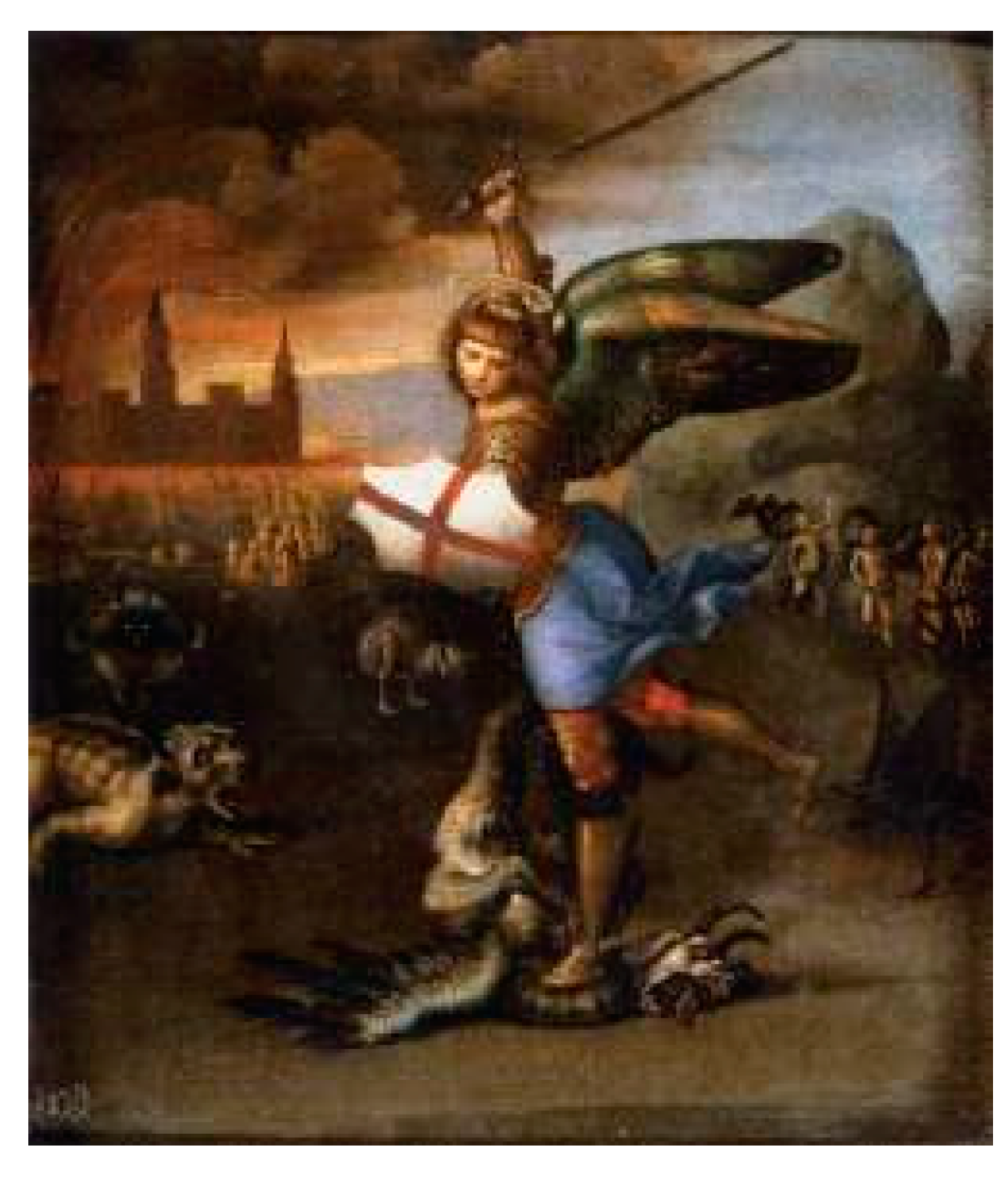
The Renaissance: Bordun’s Trope
5. Religion and Warfare in Eastern Europe: The Ideological Battle for Hearts, Minds and Souls
6. Warfare in the City: Drawing on Renaissance Traditions
7. Technique: Chiaroscuro, the Human Body, and Emptied Space
8. The Artistic Labor of Photography and C.S. Lewis
9. Conclusions
Funding
Institutional Review Board Statement
Informed Consent Statement
Data Availability Statement
Acknowledgments
Conflicts of Interest
Appendix A. Roman Bordun
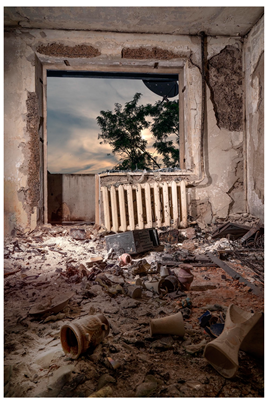

Appendix B. [Raffaello Sanzio da Urbino] Raphael
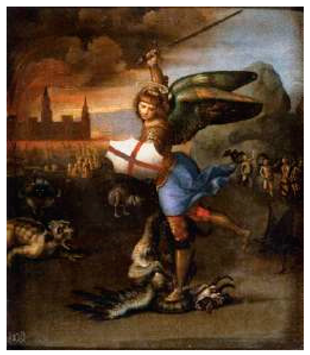
| 1 | https://foundation.app/@bordun (accessed 1 January 2025). |
| 2 | https://romanbordun.com/2023 (accessed on 8 January 2025). |
| 3 | https://foundation.app/@bordun (accessed on 8 January 2025). |
| 4 | See (Turner 1995, p. 9). Instead of a post-postmodernism, other practitioners refer to a “trans-postmodernism”, that seeks to express “‘trans-idealism’, ‘trans-utopianism’, ‘trans-originality’, ‘trans-lyricism’, ‘trans-sentimentality’. etc.”. Still other post-postmodern movements take a variety of perspectives including those who subscribe to “pseudo-modernism”, a critique of postmodernism, “metamodernism”, which critiques “pragmatic idealism”, and “cyberculturism”, considered a heir to postmodernism in its ability to create truths and realities. See Epstein (1998). |
| 5 | And God said, “Let there be light”, and there was light. 4 God saw that the light was good, and he separated the light from the darkness. 5 God called the light “day”, and the darkness he called “night”. And there was evening, and there was morning—the first day”. |
| 6 | “The Brutal Art of Early Soviet Antireligious Propaganda Posters, 1920–1940”, RareHistoricalPhotos.com, accessed 1 January 2025, https://rarehistoricalphotos.com/soviet-antireligious-propaganda-posters/. |
| 7 | “On the Anniversary of the Liberation of Irpin”. |
| 8 | “Anniversary of the Liberation of towns Bucha and Urpin”. |
References
- Arnold, Dana. 2015. A Short Book About Art. London: Tate Publishing. [Google Scholar]
- Arnold, Dana. 2020. Reading art. In Art History: A Very Short Introduction, 2nd ed. New York: Oxford University Press. [Google Scholar]
- Arnold, John Charles. 2013. The Footprints of Michael the Archangel: The Formation and Diffusion of a Saintly Cult, c. 300-c. 800. New York: Palgrave Macmillan. [Google Scholar]
- Asciuto, Nicoletta. 2025. Brilliant Modernism: Cultures of Light and Modernist Poetry. Baltimore: Johns Hopkins Press. [Google Scholar]
- Ash, Lucy. 2024. The Baton and the Cross: Russia’s Church from Pagans to Putin. London: Icon Books. [Google Scholar]
- Aylesworth, Gary. 2015. Postmodernism. In The Stanford Encyclopedia of Philosophy. Edited by Edward N. Zalta. Palo Alto: Stanford University Press. [Google Scholar]
- Baudelaire, Charles. 1955. On Photography. In The Mirror of Art, Révue Française (Paris, June 10–July 20, 1859). Edited and Translated by Jonathan Mayne. London: Phaidon Press. [Google Scholar]
- Berger, John. 1972. Ways of Seeing. New York: Penguin Classics, reprint 2008. [Google Scholar]
- Bignell, Jonathan. 2005. Big Brother: Reality TV in the Twenty-First Century. New York: Palgrave Macmillan. [Google Scholar]
- Blakkisrud, Helge, and Pål Kolstø. 2025. Legitimacy and Traditional Values in Putin’s Russia. Edinburgh: Edinburgh University Press. [Google Scholar]
- Boddice, Rob. 2019. The Developing Brain as Historical Artifact. Developmental Psychology 55: 1994–97. [Google Scholar] [CrossRef] [PubMed]
- Bordun, Roman. 2022. Let’s Leave It for Better Times. Lviv: Lviv Municipal Art Center. Available online: https://www.lvivart.center/en/exhibitions/roman-bordun-lets-leave-it-for-better-times/ (accessed on 8 January 2025).
- Brodskaïa, Nathalia. 2000. L’Art naïf. Edited by Natalia Brodskaïa. Paris: Parkstone International. [Google Scholar]
- Brown, Roland Elliott. 2019. Godless Utopia: Soviet Anti-Religious Propaganda. New York: Fuel. [Google Scholar]
- Carrier, David. 2008. A World Art History and its Objects. Pittsburgh: Pennsylvania State University Press. [Google Scholar]
- Chadwick, Owen. 1992. The Christian Church in the Cold War. London: Allen Lane. [Google Scholar]
- Chapman, Hugo, Tom Henry, and Carol Plazzotta. 2004. Raphael: From Urbino to Rome. New Haven: Yale University Press. [Google Scholar]
- Childs, Peter. 2000. Modernism. New York: Routledge. [Google Scholar]
- Clark, Elizabeth, and Dmytro Vovk, eds. 2020. Religion During the Russian Ukrainian Conflict. New York: Routledge. [Google Scholar]
- Clay, Diskin. 2014. Dante’s Parnassus: Raphael’s Parnaso. Arion: A Journal of Humanities and the Classics 22: 3–32. [Google Scholar] [CrossRef]
- Corley, Felix, ed. 1996. Religion in the Soviet Union: An Archival Reader. Berlin/Heidelberg: Springer Nature Link. [Google Scholar]
- Cormack, Robin, and Stavros Mihalarias. 1984. A Crusader Painting of St George: ’maniera greca’ or ’lingua franca’? The Burlington Magazine 126: 132–41. Available online: https://www.burlington.org.uk/archive/back-issues/198403 (accessed on 8 January 2025).
- Croatian Museum of Naïve Art. 2012. Masterpieces of Naive Art. May 9. Available online: https://hmnu.hr/ (accessed on 1 January 2025).
- Curtis, William J. R. 1996. Modern Architecture Since 1900. New York: Phaidon Press. [Google Scholar]
- Denysenko, Nicholas E. 2018. The Orthodox Church in Ukraine: A Century of Separation. Dekalb: Northern Illinois University Press. [Google Scholar]
- Denysenko, Nicholas E. 2023. The Church’s Unholy War: Russia’s Invasion of Ukraine and Orthodoxy. Eugene: Cascade Books. [Google Scholar]
- Elliott, Mark R. 2015. Why Russia’s Evangelicals Thank God for Putin. Christianity Today. January 7. Available online: https://www.christianitytoday.com/2015/01/russia-evangelical-god-putin-crimea-ukraine/ (accessed on 8 January 2025).
- Emison, Patricia A. 2012. The Italian Renaissance and Cultural Memory. Cambridge: Cambridge University Press. [Google Scholar]
- Epstein, Mikhail. 1998. “The Place of Postmodernism in Postmodernity”, and “Minimal Religion”. In Russian Postmodernism: New Perspectives on Late Soviet and Post-Soviet Culture, 2nd ed. Translated by Slobodanka Vladiv-Glover. Edited by Mikhail Epstein and Alexander A. Genis. New York: Berghahn Books. [Google Scholar]
- Everdell, William. 1997. The First Moderns: Profiles in the Origins of Twentieth Century Thought. Chicago: University of Chicago Press. [Google Scholar]
- Fichner-Rathus, Louis. 2011. Foundations of Art and Design. Boston: Cengage. [Google Scholar]
- Fiddes, Paul. 2021. Charles Williams and CS Lewis: Friends in Co-Inherence. Oxford: Oxford University Press. [Google Scholar]
- Ford, Eugene. 2017. Cold War Monks: Buddhism and America’s Secret Strategy in Southeast Asia. New Haven: Yale University Press. [Google Scholar]
- Fossi, Gloria. 2000. Italian Art: Painting, Sculpture, Architecture from the Origins to the Present Day. Firenze: Giunti. [Google Scholar]
- Frevert, Ute. 2014. Emotional Lexicons: Continuity and Change in the Vocabulary of Feeling 1700–2000. New York: Oxford University Press. [Google Scholar]
- Grubb, Nancy. 1997. Revelations: Art of the Apocalypse. Ann Arbor: University of Michigan Press. [Google Scholar]
- Hale, Sheila. 2012. Titian: His Life. New York: HarperCollins. [Google Scholar]
- Hall, Marcia B. 1994. Color and Meaning: Practice and Theory in Renaissance Painting. New York: Cambridge University Press. [Google Scholar]
- Harris, Kayla. 2022. As War Rages, Some Ukrainians Look to Mary for Protection—Continuing a Long Christian Tradition. The Conversation. March 9. Available online: https://theconversation.com/as-war-rages-some-ukrainians-look-to-mary-for-protection-continuing-a-long-christian-tradition-178394 (accessed on 8 January 2025).
- Hawkins, Peter S. 1995. Divide and Conquer. In The City of God: A Collection of Critical Essays. Edited by Dorothy F. Donnelly. New York: Peter Lang. [Google Scholar]
- Herzog, Jonathan P. 2011. The Spiritual-Industrial Complex: America’s Religious Battle Against Communism in the Early Cold War. New York: Oxford University Press. [Google Scholar]
- Hogan, Patrick Colm. 2022. Social Emotions, Diversity, and Universality. Evolutionary Studies in Imaginative Culture 6: 29–32. [Google Scholar] [CrossRef]
- Human Rights Watch. 2022. Ukraine: Apparent War Crimes in Russia-Controlled Area. April 3. Available online: https://www.hrw.org/news/2022/04/03/ukraine-apparent-war-crimes-russia-controlled-areas (accessed on 8 January 2025).
- Inboden, William. 2010. Religion and American Foreign Policy, 1945–1960: The Soul of Containment. New York: Cambridge University Press. [Google Scholar]
- Irish, Bradley J. 2019. A Strategic Compromise: Universality, Interdisciplinarity, and the Case for Modal Emotions in History of Emotion Research. Boston: Brill. [Google Scholar]
- Ivanovici, Vladimir. 2017. Divine Light Through Earthly Colours. In Colour and Light in Ancient and Medieval Art. Edited by Chloë N. Duckworth and Anne E. Sassin. New York: Taylor & Francis. [Google Scholar]
- Kaufman, Peter Iver. 2006. Redeeming Politics. Princeton: Princeton University Press. First published in 1990. [Google Scholar]
- Kent, Thomas. 2024. Reaching Believers: The Truth Shall Make You Free. CEPA. February 7. Available online: https://cepa.org/article/reaching-believers-the-truth-shall-make-you-free/ (accessed on 10 February 2025).
- Kidd, Thomas S. 2019. America’s Religious History: Faith, Politics, and the Shaping of a Nation. New York: Zondervan Academic. [Google Scholar]
- Kirby, Diane, ed. 2002. Religion and the Cold War. London: Palgrave Macmillan. [Google Scholar]
- Kivelson, Valerie A., and Robert H. Greene, eds. 2003. Orthodox Russia: Belief and Practice Under the Tsars. University Park: Penn State University Press. [Google Scholar]
- Kochetova, Julia, Yana Kononova, Roman Bordun, Evgeniv Maloletka, Lisa Bukreyeva, Roman Pashkovskiy, Alena Grom, Sergii Polezhaka, Dmytro Kozatskyi, Sasha Kurmaz, and et al. 2024. Thirteen Stories of War: Ukranian Photographers Document and Reflect on the Russian Invasion. Lviv: Ukrainian Warchive. [Google Scholar]
- Krykunov, Oleksii. 2020. A Study of the Ukranian Greek-Catholic Church from the Beginning of WWII until Perestroika. Bonn: Frederich-Wilhelms-Universität. [Google Scholar]
- Lankford, Mike. 2017. Becoming Leonardo: An Exploded View of the Life of Leonardo. New York: Melville House. [Google Scholar]
- Lesso, Rosie. 2023. 2023 What Is Chiaroscuro in Art? (5 Key Examples). TheCollector.com. April 4. Available online: https://www.thecollector.com/what-is-chiaroscuro-in-art-key-examples/ (accessed on 23 September 2023).
- Leulliette, Pierre. 1964. Saint Michael and the Dragon: A Paratrooper in the Algerian War. London: Heinemann. [Google Scholar]
- Lewis, C. S. 2014. Myth Became Fact. In God in the Dock: Essays on Theology and Ethics. Edited by Walter Hooper. London: William B. Eerdmans Publishing. [Google Scholar]
- Lyotard, Jean-François. 1979. The Postmodern Condition: A Report on Knowledge. Minneapolis: University of Minnesota Press, reprint 1984. [Google Scholar]
- Magocsi, Paul R. 2010. A History of Ukraine: The Land and Its Peoples. Toronto: University of Toronto Press. [Google Scholar]
- Marion, Jean-Luc. 2003. The Crossing of the Visible. Translated by James K. A. Smith. Stanford: Stanford University Press. [Google Scholar]
- Markushyn, Oleksandr. 2023. Destroyed But Unconquored. Available online: https://imr.gov.ua/wp-content/uploads/2023/06/3-english.pdf (accessed on 19 September 2023).
- Marson, James. 2019. Ukraine Gets a Church of Its Own—And Vladimir Putin Glowers. Wall Street Journal. August 23. Available online: https://www.wsj.com/articles/ukraine-gets-a-church-of-its-ownand-vladimir-putin-glowers-11566576051 (accessed on 8 January 2025).
- Masataka, Nobuo, and Leonid Perlovsky. 2012. The Efficacy of Musical Emotions Provoked by Mozart’s Music for the Reconciliation of Cognitive Dissonance. Scientific Reports 2: 694–744. [Google Scholar] [CrossRef] [PubMed]
- Masson, Georgina, and Marion Johnson. 1981. The Borgias. Fort Worth: Holt, Rinehart & Winston. [Google Scholar]
- Miner, Steven Merritt. 2003. Stalin’s Holy War: Religion, Nationalism, and Alliance Politics, 1941–1945. Chapel Hill: University of North Carolina Press. [Google Scholar]
- Mirovalev, Mansur. 2024. God of War’: Russian Orthodox Church Stands by Putin, But at What Cost? Al Jazeera. February 9. Available online: https://www.aljazeera.com/news/2024/2/9/far-from-harmless-patriarch-kirill-backs-putins-war-but-at-what-cost#ixzz8w0fMHVbO (accessed on 8 January 2025).
- Mitchell, W. J. Thomas. 2006. What Do Pictures Want? The Lives and Loves of Images. Chicago: University of Chicago Press. [Google Scholar]
- Mulroy, Clare. 2023. What Does ‘SOS’ Mean? The Term’s Maritime Origins and How it Shows Up in Our Lives Today. USA TODAY. May 12. Available online: https://www.usatoday.com/story/news/2023/05/12/what-does-sos-mean-its-history-and-what-it-means-on-your-iPhone/11746118002/ (accessed on 8 January 2025).
- Neumann, Dietrich. 2002. Architecture of the Night’ in the USA. In Architecture of the Night: The Illuminated Building. Munich: Prestel, pp. 52–74. [Google Scholar]
- O’Donnell, J. J. 1999. The Next Life of Augustine. In The Limits of Ancient Christianity. Edited by William E. Klingshirn and Mark Vessey. Ann Arbor: University of Michigan Press, pp. 215–31. [Google Scholar]
- Otter, Chris. 2008. Introduction: Light, Vision, and Power. In The Victorian Eye: A Political History of Light and Vision in Britain, 1800–1910. Chicago: University of Chicago Press. [Google Scholar]
- Plamper, Jan. 2015. History of Emotions: An Introduction. New York: Oxford University Press. [Google Scholar]
- Potter, Garry, and José Lopez, eds. 2005. After Postmodernism: An Introduction to Critical Realism. London: The Athlone Press. [Google Scholar]
- Preisinger, Raphaèle, ed. 2021. Medieval Art at the Intersection of Visuality and Material Culture: Studies in the ‘Semantics of Vision’. Belgium: Brepols. [Google Scholar]
- Preston, Andrew. 2012. Sword of the Spirit, Shield of Faith: Religion in American War and Diplomacy. New York: Alfred A. Knopf. [Google Scholar]
- Pugh, Emily. 2014. Architecture, Politics, & Identity in Divided Berlin. Pittsburgh: University of Pittsburgh Press. [Google Scholar]
- Pullella, Philip. 2022. Ukraine Invasion Splits Orthodox Church, Isolates Russian Patriarch. Reuters. March 14. Available online: https://www.reuters.com/world/europe/ukraine-invasion-splits-orthodox-church-isolates-russian-patriarch-2022-03-14 (accessed on 8 January 2025).
- Radenovic, Ljiljana, and I.L. Akkad. 2022. History of Emotional Suffering: From Emotions to Needs in the History of Emotions. History and Theory: Studies in the Philosophy of History 61: 96–123. [Google Scholar] [CrossRef]
- Ramet, Sabrina Petra, ed. 2005. Religious Policy in the Soviet Union. New York: Cambridge University Press. [Google Scholar]
- Reddy, William M. 2001. The Navigation of Feeling: A Framework for the History of Emotions. Cambridge: Cambridge University Press. [Google Scholar]
- Risatti, Howard. 2009a. A Theory of Craft: Function and Aesthetic Expression. Chapel Hill: University of North Carolina Press. [Google Scholar]
- Risatti, Howard. 2009b. Aesthetics and the Function/Nonfunction Dichotomy. In A Theory of Craft: Function and Aesthetic Expression. Chapel Hill: University of North Carolina Press. [Google Scholar]
- Ruble, Sarah E. 2012. The Gospel of Freedom and Power. Chapel Hill: University of North Carolina Press. [Google Scholar]
- Schmidt, Leigh Eric, and Sally M. Promey. 2012. American Religious Liberalism. Bloomington: Indiana University Press. [Google Scholar]
- Smolkin, Victoria. 2018. A Sacred Space Is Never Empty: A History of Soviet Atheism. Princeton: Princeton University Press. [Google Scholar]
- Soldatov, Andrei, and Irina Borogan. 2023. Putin’s Useful Priests: The Russian Orthodox Church and the Kremlin’s Hidden Influence Campaign in the West. Foreign Affairs. September 14. Available online: https://www.foreignaffairs.com/ukraine/putins-useful-priests-russia-church-influence-campaign (accessed on 8 January 2025).
- Spinks, Bryan D. 2002. The Sanctus in the Eucharistic Prayer. New York: Cambridge University Press. [Google Scholar]
- Stabenow, Cornelia. 1994. Rousseau. New York: Taschen America. [Google Scholar]
- Stein, Edith. 2011. The Science of the Cross. Washington, DC: ICS Publications. [Google Scholar]
- Stoeckl, Kristina. 2022. The Use of Religious Arguments fo the Justification of the Russian Invasion of Ukraine. BYU Law International Center for Law and Relgion Studies, March 18. Available online: https://talkabout.iclrs.org/2022/03/18/the-use-of-religious-arguments-for-the-justification-of-the-russian-invasion-of-ukraine/ (accessed on 8 January 2025).
- Stoeckl, Kristina, and Dmitry Uzlaner. 2022. The Moralist International: Russia in the Global Culture Wars. New York: Fordham University Press. [Google Scholar]
- Storey, Wayne. 2010. Dis. In The Dante Encyclopaedia. London: Routledge. [Google Scholar]
- Tataryn, Myroslaw Ivan. 1992. The re-emergence of the Ukrainian (Greek) Catholic Church in the USSR. In Religious Policy in the Soviet Union. Edited by Sabrina Petra Ramet. New York: Cambridge University Press. [Google Scholar]
- Telford, Lynda. 2020. Women of the Vatican: Female Power in a Male World. Stroud: Amberley Publishing. [Google Scholar]
- Turner, Tom. 1995. City as Landscape: A Post Post-modern View of Design and Planning. New York: Taylor and Francis. [Google Scholar]
- Tyneh, Carl S. 2003. Orthodox Christianity: Overview and Bibliography. Happague: Nova Publishers. [Google Scholar]
- United Nations News. 2023. Ukraine: Rape and Torture by Russian Forces Continuing, Rights Experts Report. United Nations News. May 25. Available online: https://news.un.org/en/story/2023/09/1141417 (accessed on 8 January 2025).
- UNOSTAT. 2022. UNOSAT Damage Assessment Overview Map—Ukraine: Irpin City, Kyivska Oblast, Imagery Analysis: 31 March 2022 Published: 7 April 2022 V1. September 15. Available online: https://reliefweb.int/map/ukraine/unosat-damage-assessment-overview-map-ukraine-irpin-city-kyivska-oblast-imagery-analysis-31-march-2022-published-07-april-2022-v1-0 (accessed on 8 January 2025).
- van Eikema Hommes, Margriet. 2000. Discoloration or Chiaroscuro? An Interpretation of the Dark Areas in Raphael’s ‘Transfiguration of Christ’. Simiolus: Netherlands Quarterly for the History of Art 28: 4–15. [Google Scholar] [CrossRef]
- Vasari, Giorgio. 1991. The Lives of the Artists. Translated by Julia Conaway Bondanella, and Peter Bondanella. London: Oxford University Press. [Google Scholar]
- Vautier, Adrien, and Lawrence Cornet. 2023. Irpin One Year After Liberation. Le Monde. April 10. Available online: https://www.lemonde.fr/en/international/article/2023/04/10/irpin-one-year-after-liberation-a-city-symbolizing-ukrainian-resistance_6022383_4.html (accessed on 20 September 2023).
- Villari, Pasquale. 2007. Death of Alexander VI. In Niccolò Machiavelli and His Times. Singapore: C. K. Paul & Company, vol. 4. [Google Scholar]
- von Balthasar, Hans Urs. 2009. The Aesthetic Measure. In The Glory of the Lord: A Theological Aesthetics. Volume I: Seeing the Form. Translated by Erasmo Leivá-Herikakis. San Francisco: Ignatius Press. First published in 1982. [Google Scholar]
- Williams, Rowan. 2005. Art and Intelligence: Towards a New Theology. In Grace and Necessity: Reflections in Art and Love. Harrisburg: Morehouse. [Google Scholar]

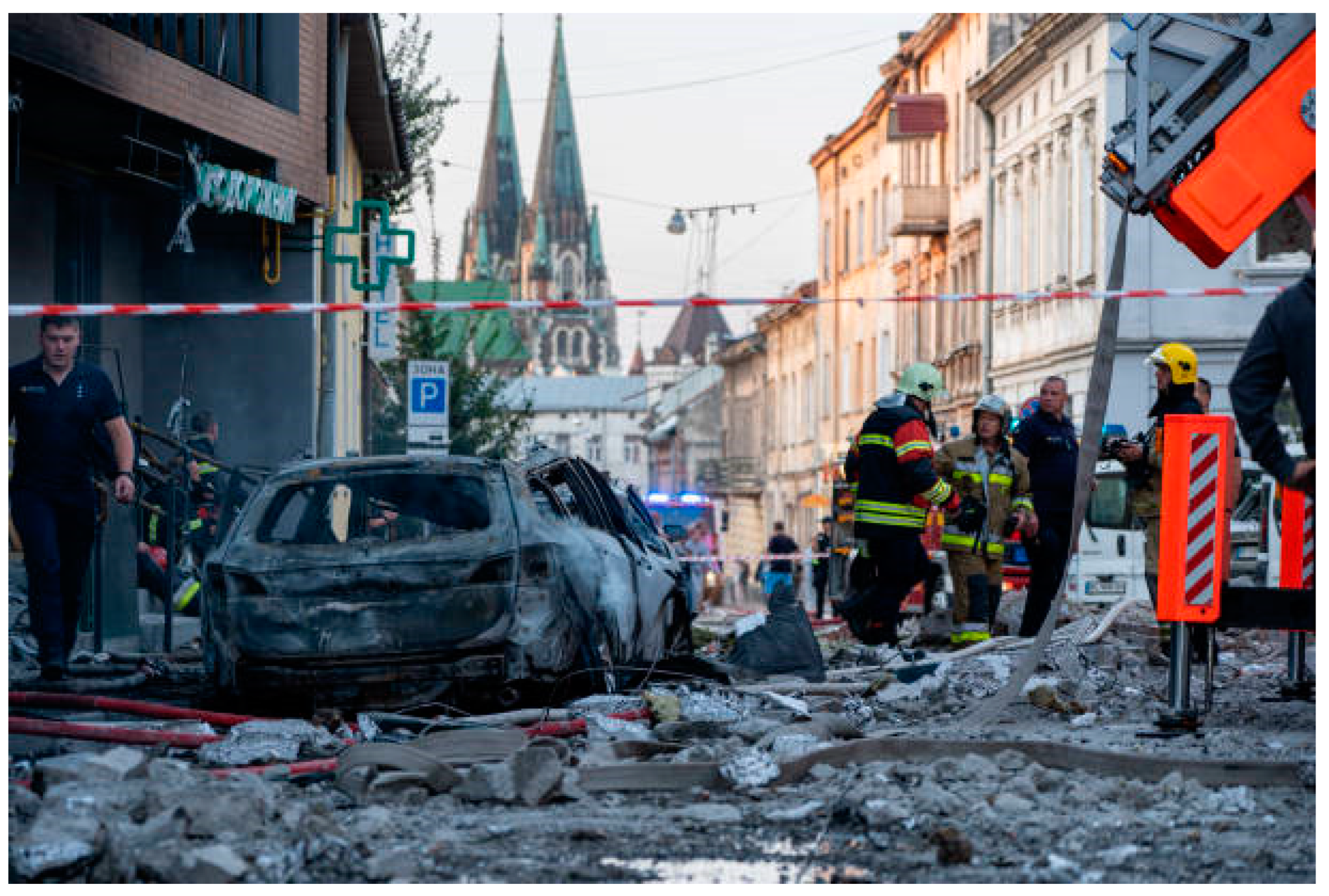
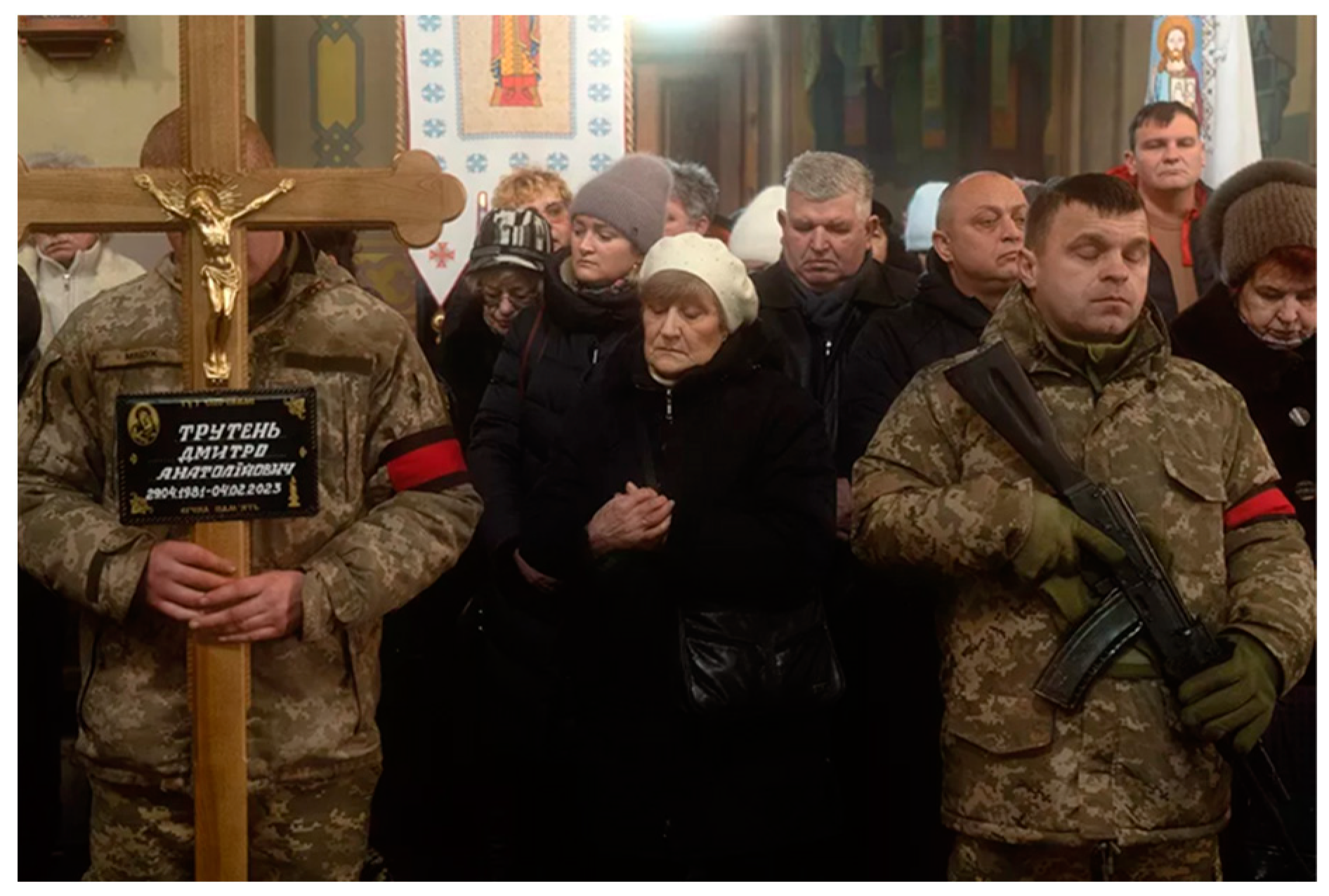
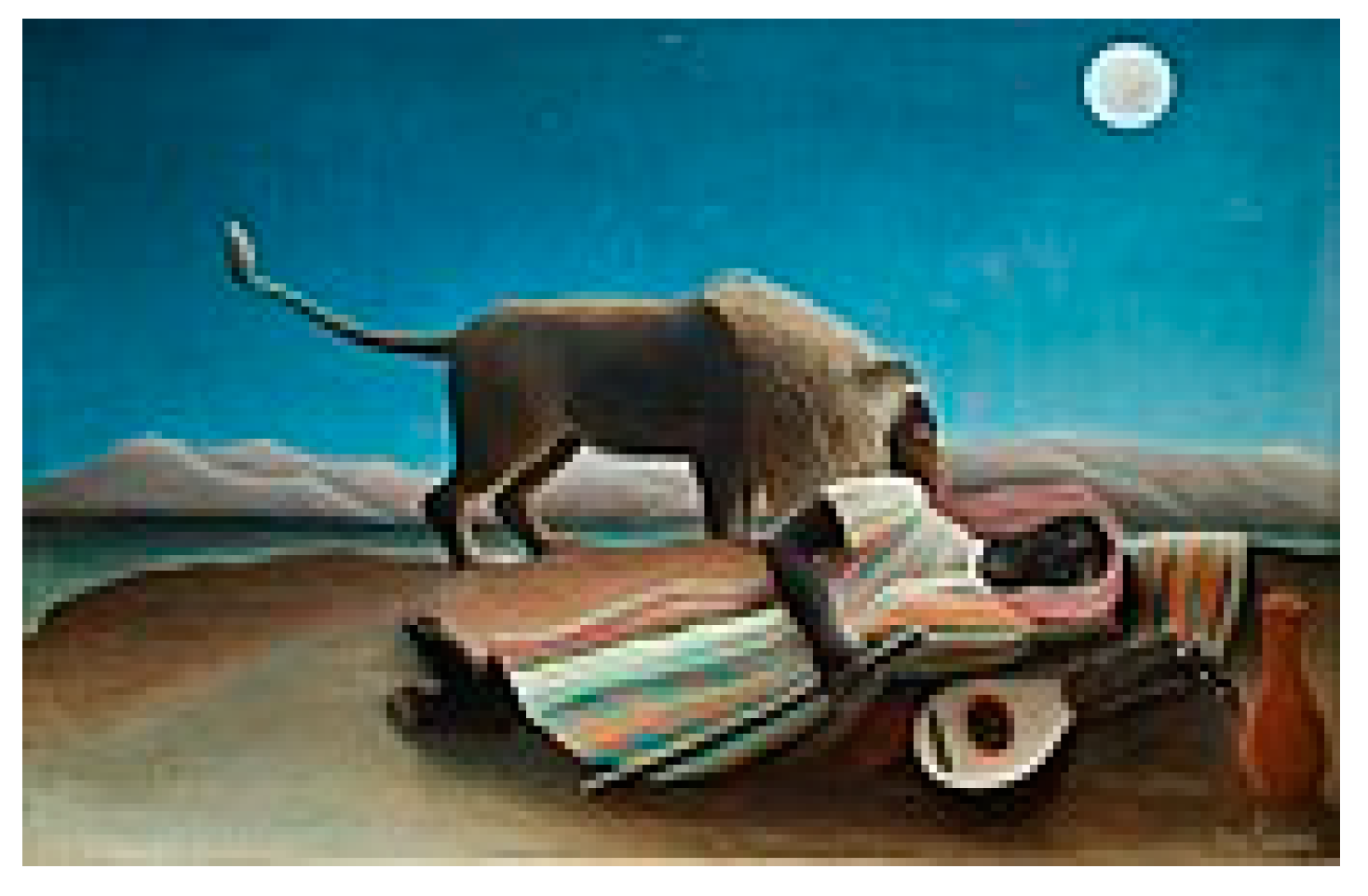
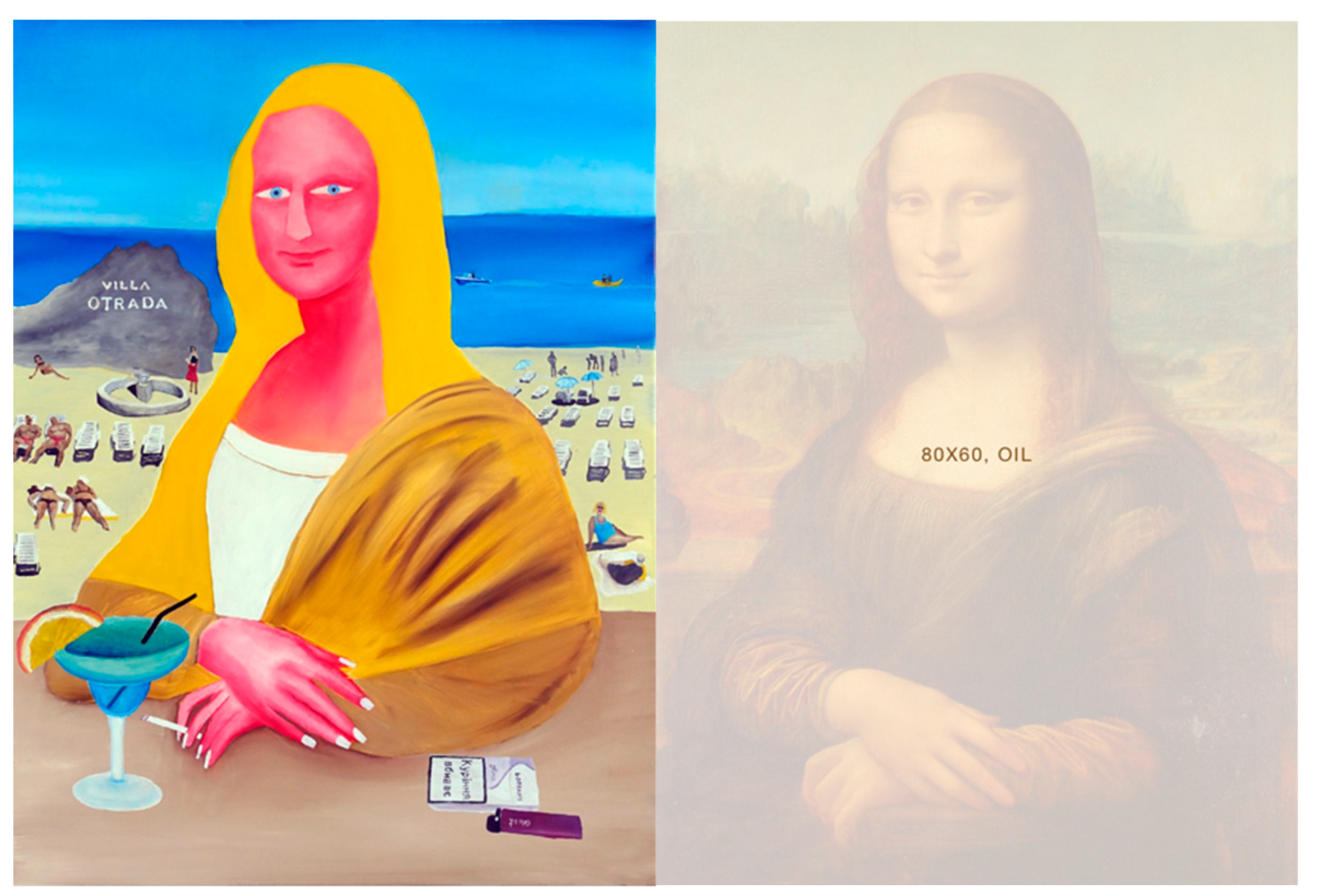
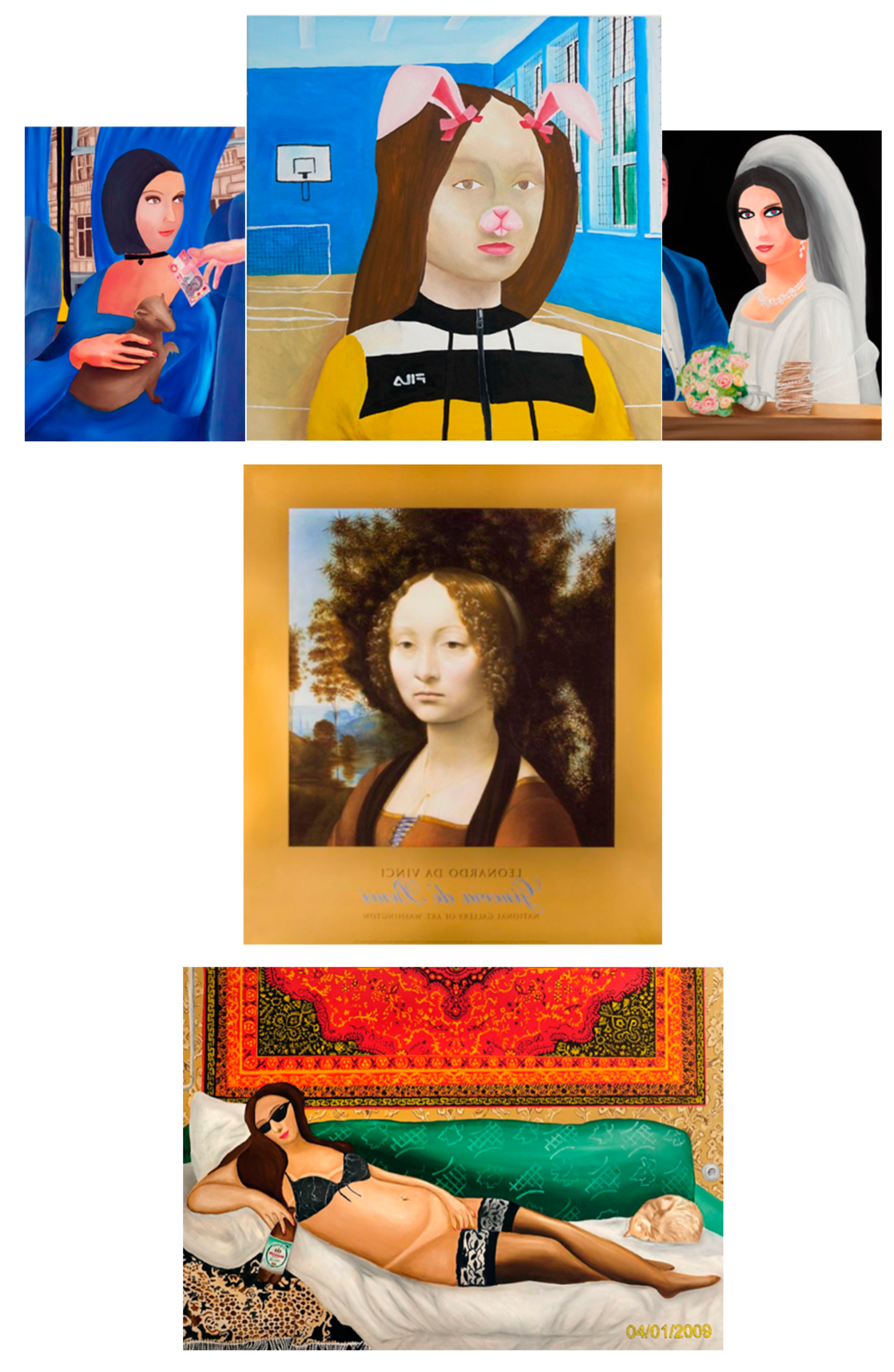
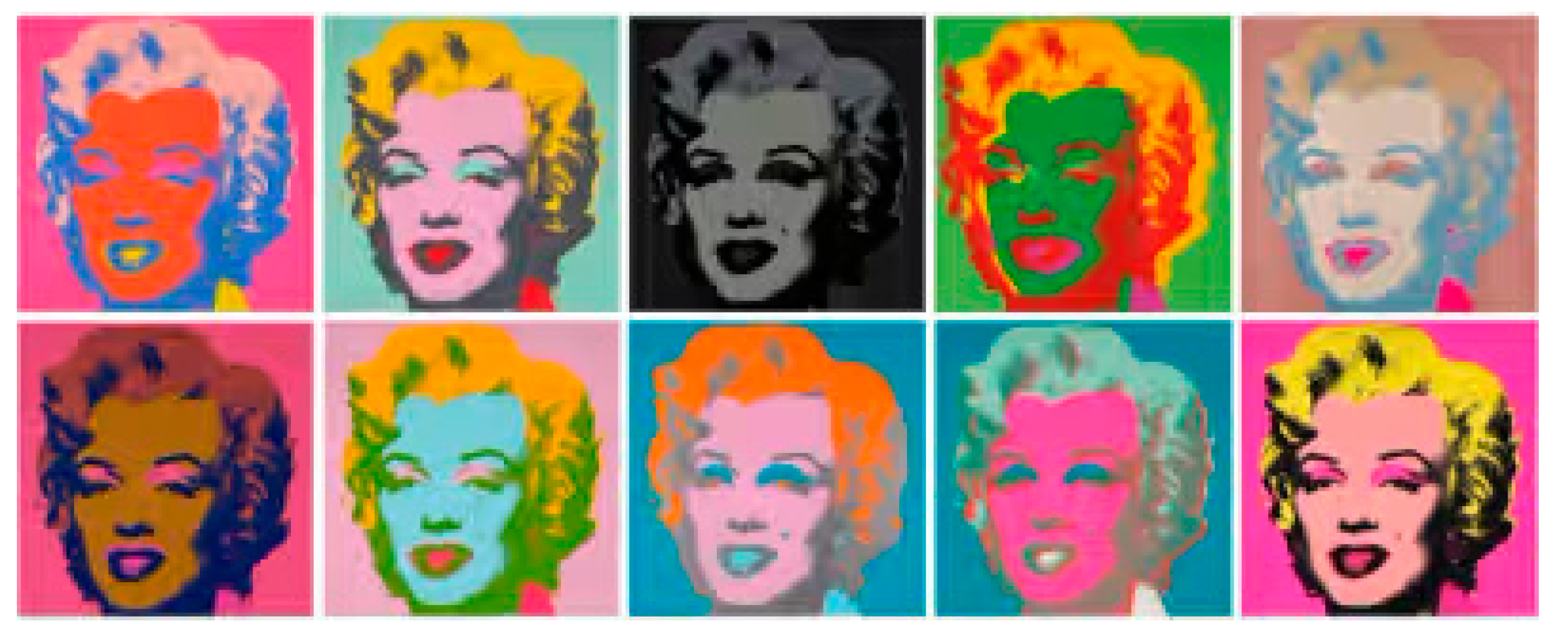

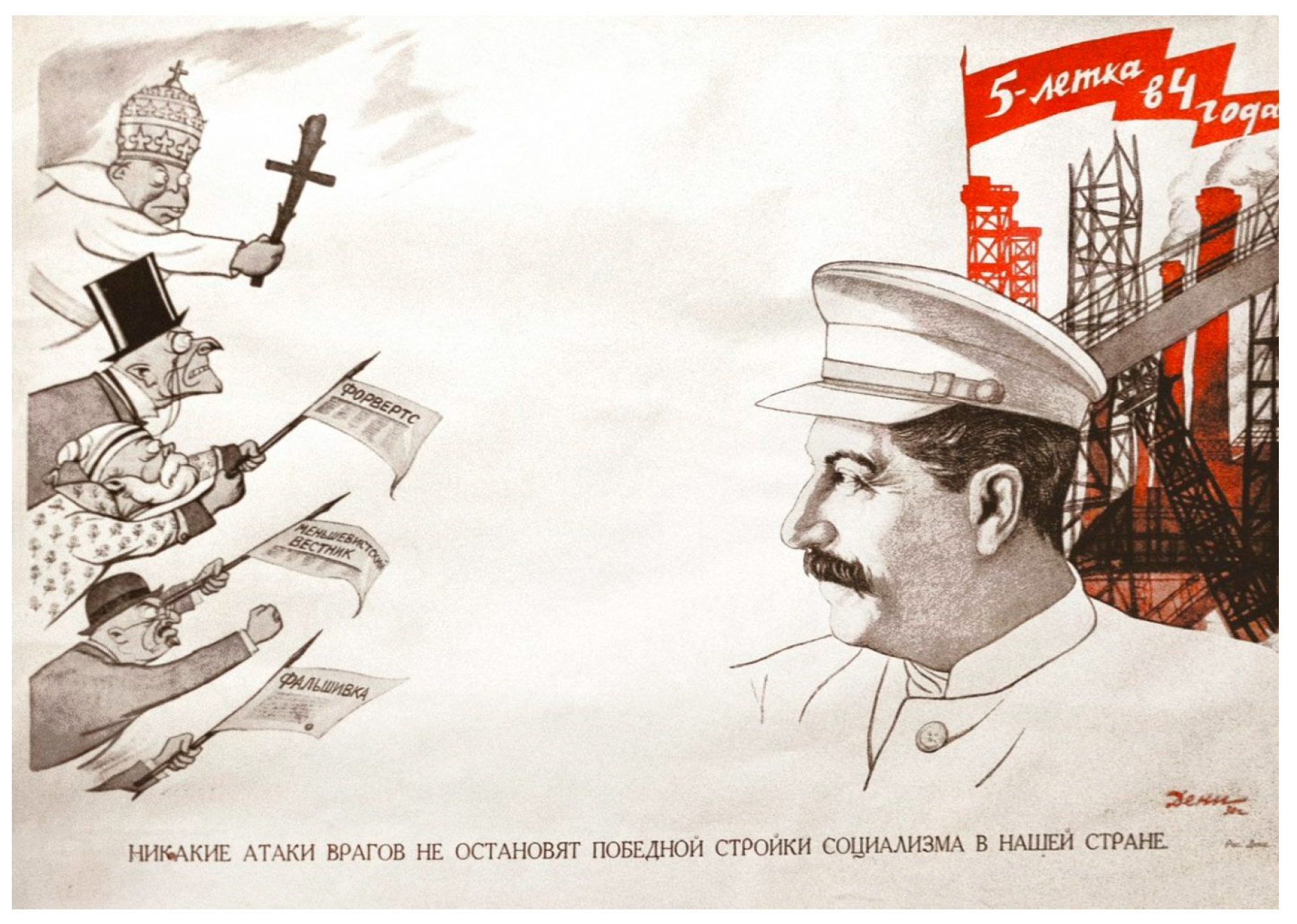
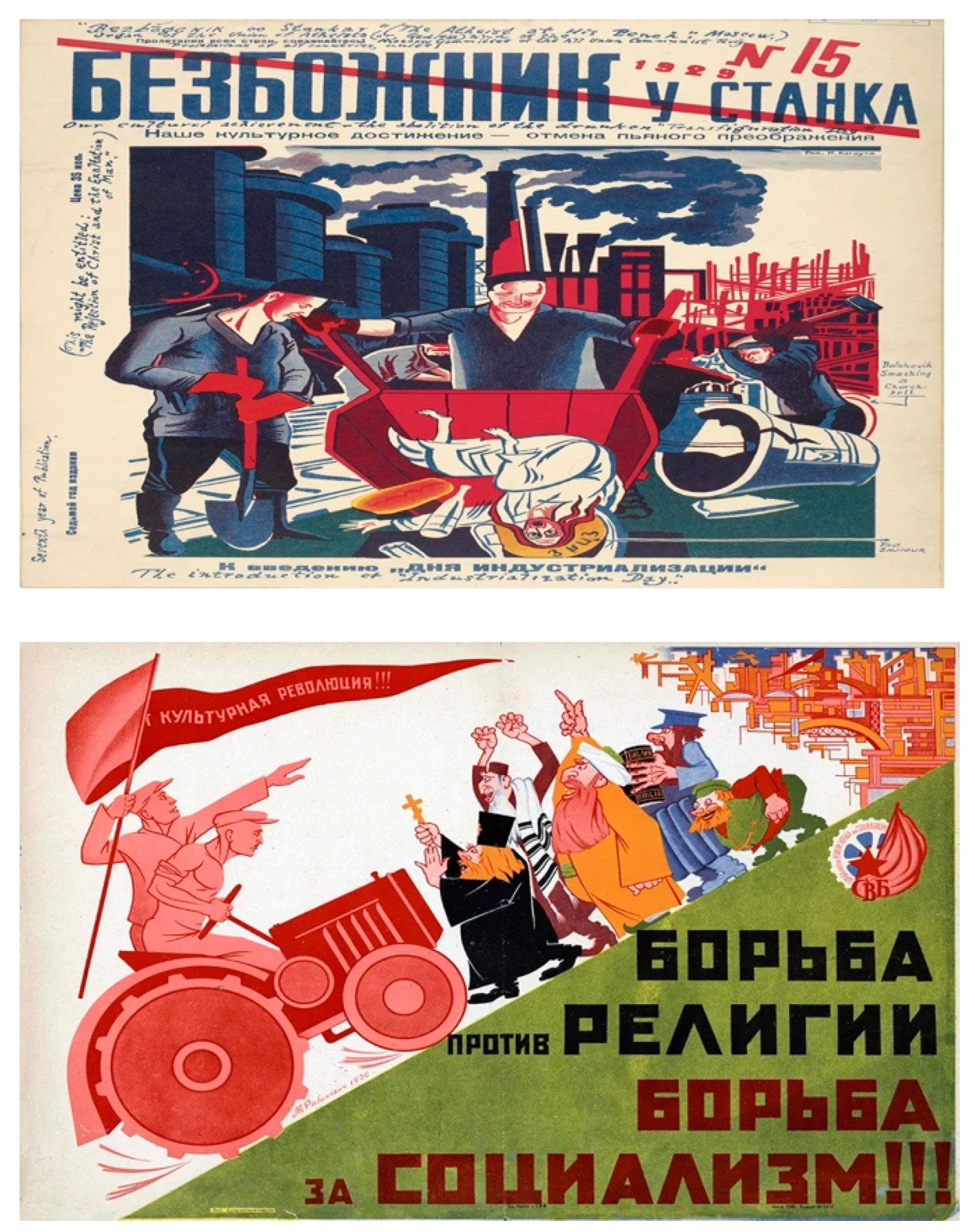
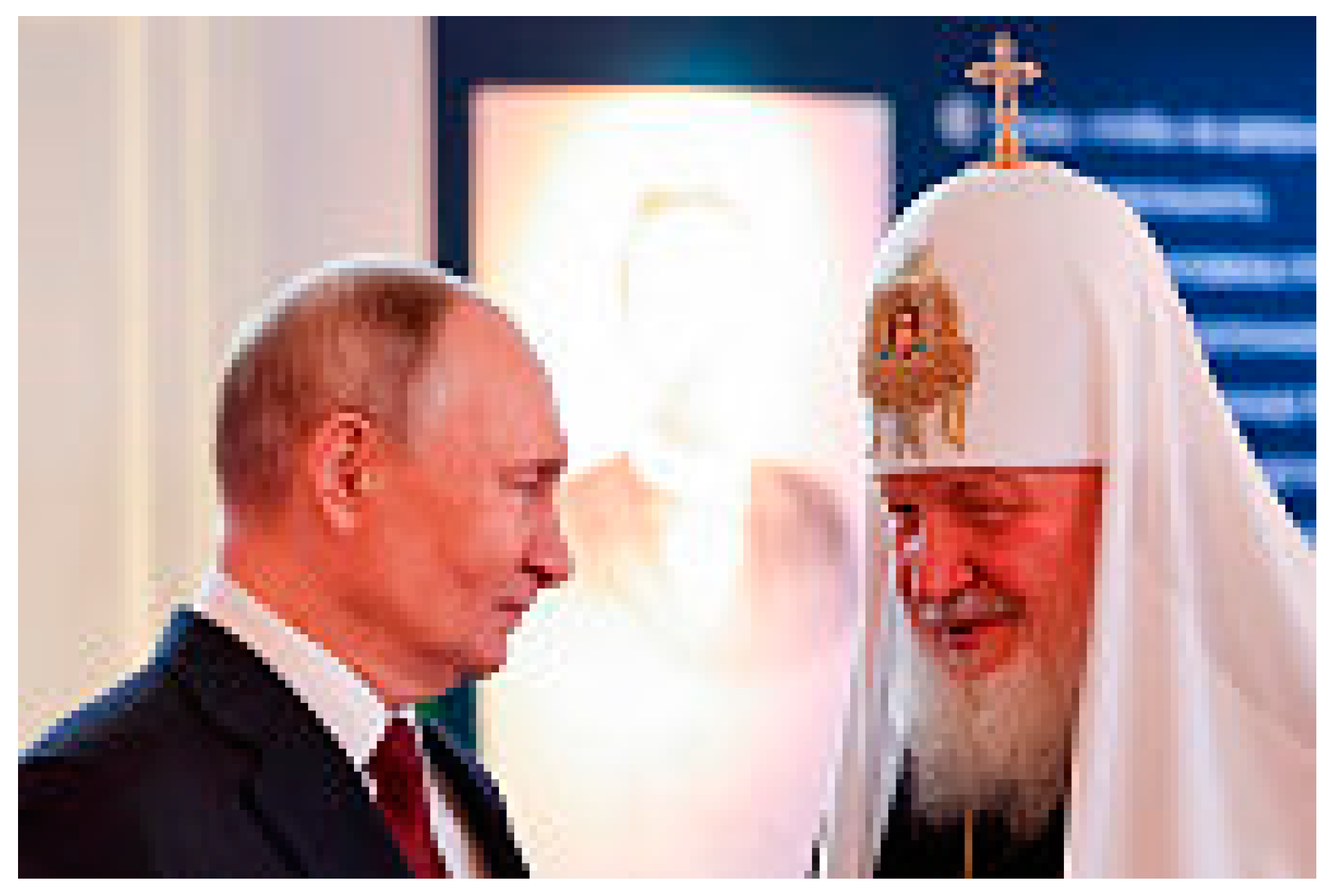
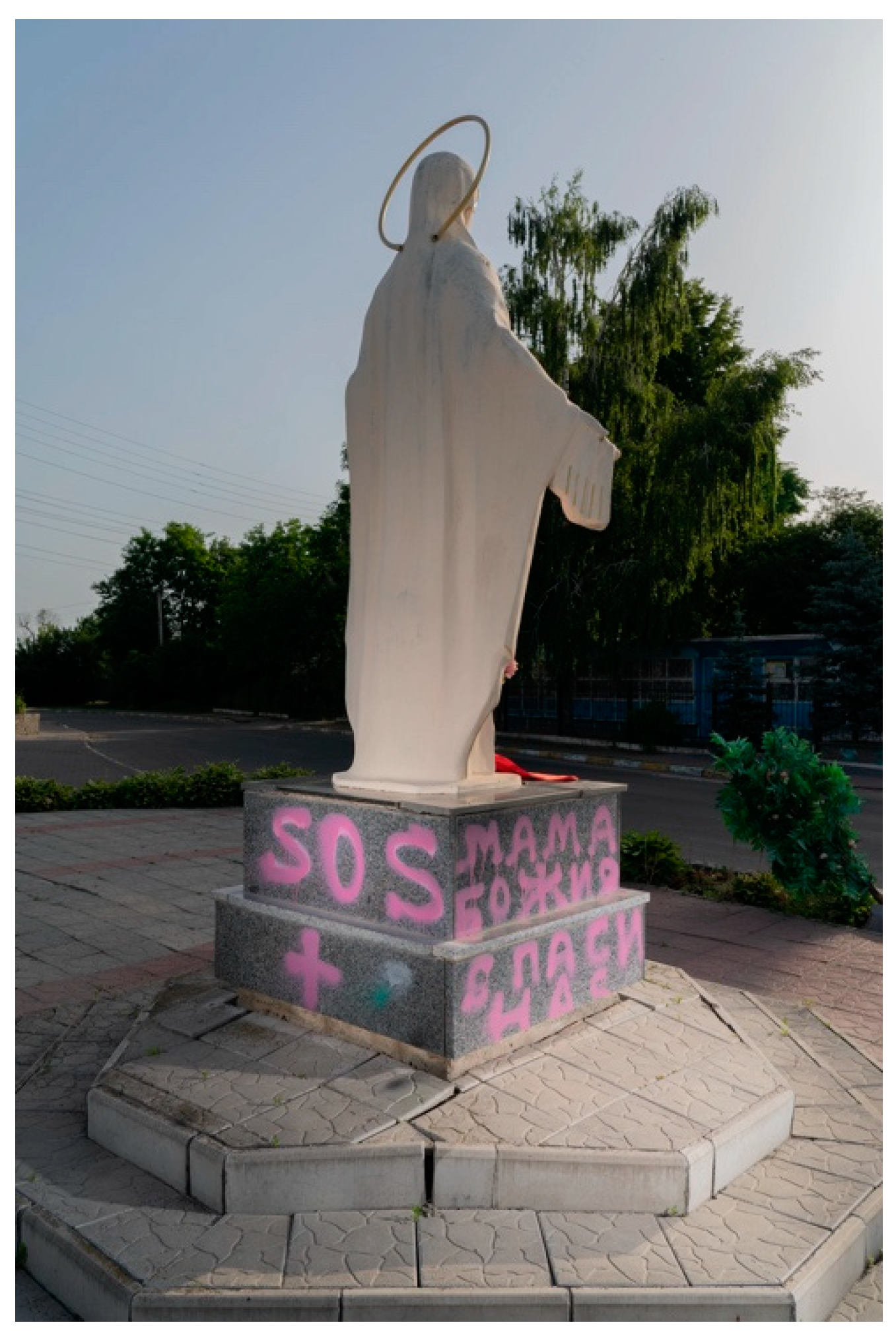
Disclaimer/Publisher’s Note: The statements, opinions and data contained in all publications are solely those of the individual author(s) and contributor(s) and not of MDPI and/or the editor(s). MDPI and/or the editor(s) disclaim responsibility for any injury to people or property resulting from any ideas, methods, instructions or products referred to in the content. |
© 2025 by the author. Licensee MDPI, Basel, Switzerland. This article is an open access article distributed under the terms and conditions of the Creative Commons Attribution (CC BY) license (https://creativecommons.org/licenses/by/4.0/).
Share and Cite
Phillips, V. Christian Revelation in the Photographic Arts: Urban Warfare, Light as a Borrowed Metaphor, and Roman Bordun’s The Apartment After the Artillery Bombardment in Ukraine. Religions 2025, 16, 236. https://doi.org/10.3390/rel16020236
Phillips V. Christian Revelation in the Photographic Arts: Urban Warfare, Light as a Borrowed Metaphor, and Roman Bordun’s The Apartment After the Artillery Bombardment in Ukraine. Religions. 2025; 16(2):236. https://doi.org/10.3390/rel16020236
Chicago/Turabian StylePhillips, Victoria. 2025. "Christian Revelation in the Photographic Arts: Urban Warfare, Light as a Borrowed Metaphor, and Roman Bordun’s The Apartment After the Artillery Bombardment in Ukraine" Religions 16, no. 2: 236. https://doi.org/10.3390/rel16020236
APA StylePhillips, V. (2025). Christian Revelation in the Photographic Arts: Urban Warfare, Light as a Borrowed Metaphor, and Roman Bordun’s The Apartment After the Artillery Bombardment in Ukraine. Religions, 16(2), 236. https://doi.org/10.3390/rel16020236



